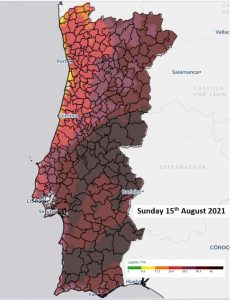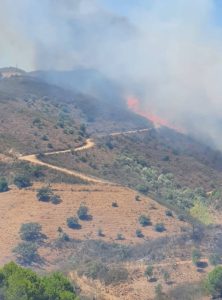Portugal Situation Report Wednesday 18th August 2021
By David Thomas, President Safe Communities Portugal
Good morning – This morning we are only producing general reports for Madeira, Azores and Algarve due the fire at Castro Marim over the last two days. This Portugal report will therefore focus on important points concerning prevention, self-protection and reporting of fires, as this a high priority at present.
The fire in Castro Marim (or had it been anywhere else in the Algarve) was not unexpected, given the weather conditions.

Although relatively few fires start at 01.00 hrs in the morning, this one did and spread fairly quickly. Being at night time, air means could not be deployed and for fire fighters on the ground access was extremely difficult, resulting in the fire to spread quickly driven by moderate winds. It was brought under control early on 16th, but re-ignited and is now under conclusion. Our major incident page here has all the updates.
OUR ROLE
Our role at Safe Communities, as it was when I spent over 30 years as a police officer, is to protect life and property. For that reason SCP trained for and became Portugal’s only Civil Protection Voluntary Organisation under Portuguese law in the area of communication in particular to the international community living and visiting here.
We attended numerous civil protection exercises, visited command posts during incidents, and entered into formal agreements with the ANEPC, as well as becoming part of the National Civil Protection plan, plus working closely with fire behavioural experts. As such in times of crisis we can call upon the relevant authorities for guidance, advice and information when required as in carrying out our statutory duties. As a legal entity we can provide advice; whereas many other try to do so, with no accepted qualification in Portugal to do so. When you see this on social media please therefore take care.
PREVENTION AND SELF-PROTECTION
 In the weeks leading up to the Castro Marim fire we have been posting both the normal fire risk map and chart, as well as the rural fire hazard in other words the FWI. With the latter we have drawn comparisons with the Monchique fire of 2018 as the current conditions are similar with the FWI then, which determine how quickly fires can start and spread, at Extreme 64 and above.
In the weeks leading up to the Castro Marim fire we have been posting both the normal fire risk map and chart, as well as the rural fire hazard in other words the FWI. With the latter we have drawn comparisons with the Monchique fire of 2018 as the current conditions are similar with the FWI then, which determine how quickly fires can start and spread, at Extreme 64 and above.
With these reports we have added links to our website and provided information on self-protection in the event of fires. I hope you seen these, shared this information, and are by now fully aware of what steps to take should a fire approach your home.
Judging by the number of shares and reaches on our Facebook page, what it shows is that fires themselves once started, become far more newsworthy and are as consequence shared more widely, well beyond the communities affected. If preventive advice was as widely shared, people would become more informed and the risk of fires would decrease, because behaviour would change.
I give an example; yesterday we published posts cornering the dangers of smoke and the importance of self-protection and they were widely shared, simply because a major fire was taking place, and for some people it had unfortunately become a reality.
It is easy to become complacent and think “well it will never happen to me”, but in doing this, one can become exposed to danger, due to not understanding the risks. In extreme cases the consequences could be fatal. If you have every experienced a fire you will know that fires can burn with great intensity and spread very quickly. It was reported that at one stage the Castro Marim fire was consuming some 650 hectares an hour! In these situations there is no time to make plans, so it is important to plan well ahead.
WHY SELF-PROTECTION IS NECESSARY
 The second point I wish to make is that fire fighters may not always be able to reach you quickly should a fire approach your home. This could be due to difficulty of access in isolated areas, with no proper roads, especially at night time, or during a major fire covering a large area with a long perimeter. In the Castro Marim fire yesterday the perimeter was stated at 43 Kms! At some stages yesterday some 600+ fire fighters were deployed. However, not all of those are actively fighting fires! For example the total includes drivers, logistics, those taking a well-deserved rest, meal breaks, change of shift for example – so for all these reasons in a large fire you may find yourself alone for a period of time. Learning about self-protection is therefore vitally import ant.
The second point I wish to make is that fire fighters may not always be able to reach you quickly should a fire approach your home. This could be due to difficulty of access in isolated areas, with no proper roads, especially at night time, or during a major fire covering a large area with a long perimeter. In the Castro Marim fire yesterday the perimeter was stated at 43 Kms! At some stages yesterday some 600+ fire fighters were deployed. However, not all of those are actively fighting fires! For example the total includes drivers, logistics, those taking a well-deserved rest, meal breaks, change of shift for example – so for all these reasons in a large fire you may find yourself alone for a period of time. Learning about self-protection is therefore vitally import ant.
When you next see our messages on this subject please share, because by doing so you are helping others.
REPORTING OF FIRES
Each day at this time of the year there can upwards of around 40 fires sometimes reaching over one hundred. This is too many, but a vast reduction compared to over 300 per day during the worst of the 2017 fire period. The vast majority of rural fires take place in isolated areas and do not pose a threat to life or property, and the vast majority are extinguished quickly, normally within one hour due to the great work of the emergency services.
These fires are monitored by Civil Protection through their dashboard and through Fogos.pt https://fogos.pt/ which has an automatic link to the ANEPC dashboard downloading information, but with more features, including location maps. This is important as it ensures accuracy, and avoids human error. We have been requesting for some time to the ANEPC headquarters for more information concerning fires particularly maps showing the extent of areas burned, and the direction of active fires etc. We are very pleased therefore that starting recently this is now being done.
Although we monitor all rural fires, we do not report each and every one, such as stating the number of operatives, vehicles and aircraft as that alone provides very little information concerning the fire situation, especially where exactly the fire is and which direction it is moving in for example. Our criterial for creating SITREPS (situation reports), is when the fires has exceed the initial attack stage; and or if it poses a threat to life or property; it becomes a major incident declared by the ANEPC or there multiple fires in a close area. In such cases we create a Facebook post updated regularly, linked to a major incident page (in serious cases) on our website with as much relevant and accurate information available.
This ensures that there is a proper audit of communication from start to finish in major incidents, as well as consistency in reporting using a well-defined criteria.
We thank our colleagues at Brits in Portugal, various organisations and groups for sharing this important safety information.
Have a Safe Day.
